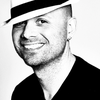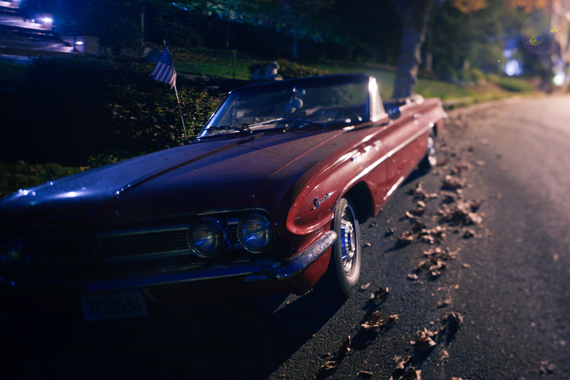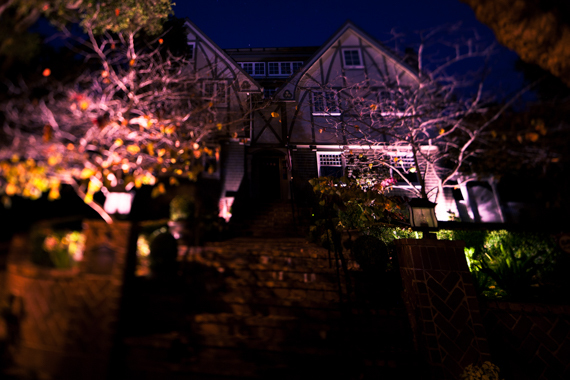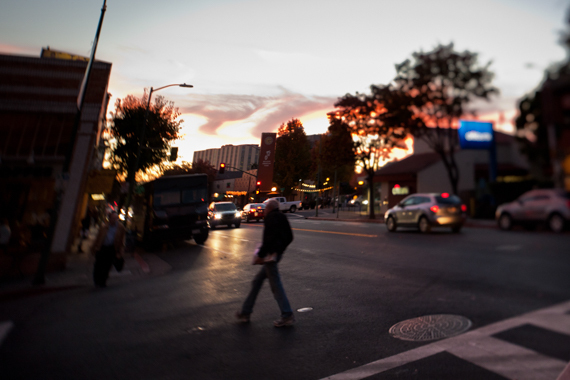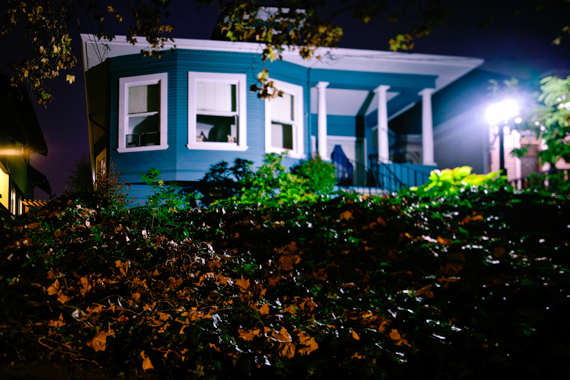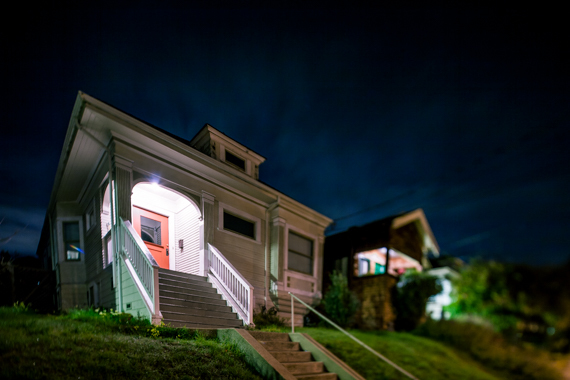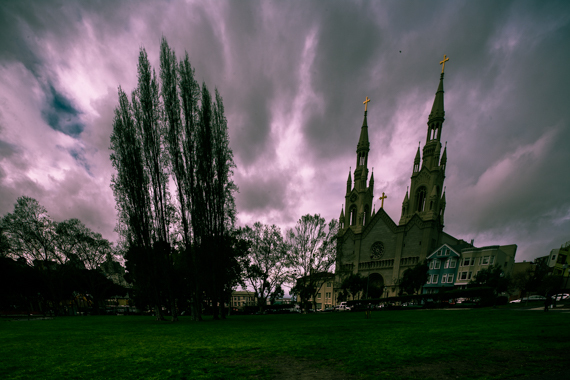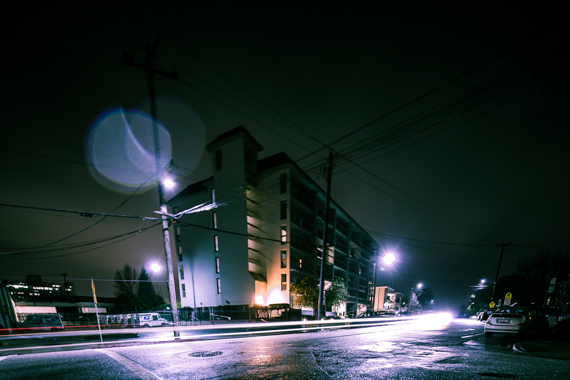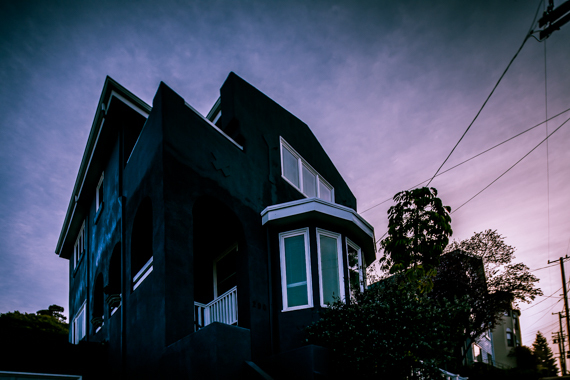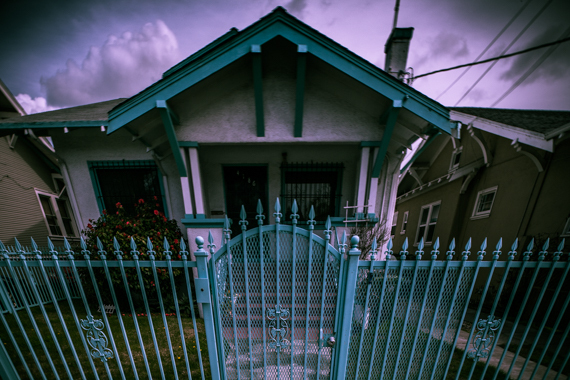As Halloween draws closer and closer, I decided I'd need to find some spooky photos to feature here on the blog. As luck would have it, Rob Reeves and his tilt shift terror project fell right into my lap. How timely. Although I am normally not a fan of "trick" photography - some will be annoyed that I consider tilt shift a trick - I really do like this work. It is done well and to great effect. There is something special about the way Rob frames these images, chooses the subject matter, and makes use of color. It all combines to not only make some great and very unique images, but spooky ones too!
Just in time for Halloween, we are treated here to some very spooky houses and other street scenes. In fact, I imagine some of these homes to look kind of like they might when seen through a lopsided mask - quite like many kids and adults alike will adorn in the coming days. So go ahead, take a look at Rob's work and get spooked!
Michael Ernest Sweet: Rob, I have to say I am normally not a fan of tilt-shift photography. I'm kind of a plain Jane when it comes to photography. I don't like HDR much either. I guess, frankly, I think an image should have power and effect without resorting to gimmicks. All that aside, I like this work - a lot. There is something cinematic to the effect here that really does enhance the idea of horror. How did this series come about?
RR: First off, I should point out that I'm not using any HDR here. Outside of basic exposure/contrast/color corrections, all of this stuff was made in camera. But I digress. This series came about through simple exploration of equipment. I rented a tilt shift lens and started exploring it's capabilities. I've always loved architecture and night photography, so it all just came together.
MES: Oh, sorry. I wasn't suggesting that you were using HDR, I was merely doing a brief inventory of the techniques which I don't like. Moving on, why the horror angle? Have you always had a fascination with the horror genre? I ask because as a child of the 80s, I have always been a big fan of the horror movie. Did you draw any inspiration from that era of cinema?
RR: I'm actually really uninterested in horror movies generally. That's not to say I don't like thrilling movies, but the classic blood-drenched horror movie doesn't do much for me. I'm way more interested in movies like Event Horizon, 2001: A Space Odyssey, Jurassic Park, Alien, etc., as well as the works of HP Lovecraft, where the horror is always off screen and the sets play a huge role in the tension. A stabbing is just gross, but an unseen force of nature is truly unsettling.
MES: It seems to me that color is rather important to this series. What made you go with color and do you think the photographs would have the same impact in black and white?
RR: I really, really love that sickly, subtle green I can pull out of the shadows sometimes. It's unnatural and earthy. Maybe it harkens back to that force of nature angle. I've converted them to black and white to play around and really liked some of the results, but for consistency's sake I've left them in color. Maybe one day I'll do something more monochrome on film.
MES: Can you tell us about the equipment you used in this series and the technique you employed?
RR: Most of it is shot on a 17mm tilt shift lens, with some of the earlier work done on a 24mm tilt shift. All of it is on a Canon 5D Classic except for maybe one or two very recent ones where I had access to a 5Dmk3.
The technique is pretty basic. I'll walk around late at night, usually around midnight, and when I find a house I'd like to take a picture of I try and focus to the best of my ability, hold the remote button for a spell, then check my exposure and adjust from there. When I get home I do some basic contrast adjustments in Lightroom, split toning, and more often than not leveling it off. That lens makes it surprisingly hard to keep things level.
MES: It seems you are primarily a commercial photographer (weddings, portraits etc.) and yet you've created this series. Do you do anything else we should know about you aside from the weddings and portraits? Street or fine art or experimental, for example.
RR: Most of my photography is street photography, but that's a function of it being something I can do all the time. This series was actually a senior project in college that I kept doing after graduation, and I keep finding things to do with the lens. I'm also doing a lot more film photography lately, but there's not a lot of that to share, as darkroom printing is super, super hard to do well.
MES: How did you get into photography anyway?
RR: Smartphones. I had an iPhone 3Gs, a slough of apps, and a summer in San Francisco to mess around. After that I bought myself a point and shoot camera, and then a beginning dSLR, and on and on. Soon I was getting my degree in photography and figuring out how to do this full time.
MES: Who are some of the photographers who've inspired you the most? Please tell us about some contemporaries as well as masters.
RR: I grew up with an Ansel Adams calendar in the house, so I'm sure some of that soaked in, possibly in direct opposition to the Edward Steichen book that was in the family's library. Ralph Eugene Meatyard has an awesome sense of unreality and works the shadows very well. Josef Koudelka combines documentary, street and landscape photos together beautifully. When I was introduced to his work it was very validating. Lately I've been getting more and more into street photography, so people like Garry Winogrand and Robert Frank, not to mention the beautifully bizarre photos of Diane Arbus have really been sinking in (I hope).
As far as contemporary work, I'm really inspired by Andreas Gursky for his monumental scale and Todd Hido, who does creepy night time pictures of houses about one thousand times better than me. I'd also like to throw in Moriyama and Ralph Gibson for those beautiful, high contrast black and white images.
MES: Is this series over or do you have some grand plan in mind for this work?
RR: I'll probably keep making them, but not at the same rate I was. It's difficult to find the time and motivation to leave the house and traipse around the neighborhood so late at night with expensive equipment. I've actually been doing street photography with the same camera/lens setup, and it's been a lot of fun. I'm actually working on a small zine of tilt shift street photos, so it's going to have a very different feel.
MES: Are you completely digital or do you work with analogue as well? Just curious, I've recently gone back to a 100% analogue workflow and I love it. So I'm always asking to see where others are with this fork in the road.
RR: Professional and commercial work is done digitally for the fast turnaround time and safety net for sure. I'm also doing this project digitally so I can check focus and exposure on the fly. Anything else is about 50% film these days. Film has become something of a meditation for me. I love getting in the darkroom and making prints, having a physical print, and it's so different than anything I get out of a digital camera. Film really lets me feel like I made something.
MES: I couldn't agree more. I think there is something about photography that will always necessitate the use of film to be truly authentic. Digital is great and has its place but I think the idea that it must kill film at some point is over. After all, television didn't kill the radio star. Not exactly anyway. Rob, thanks for this, it was great to speak with you.
RR: Great speaking with you, too! And if I may add one thing about film photography, there's currently a kickstarter for Film Ferrania going, which should have a few days left when this goes up.
Rob Reeves is an Oakland-based photographer. He specializes in portraiture, street, documentary and fine art photography (which are really all the same thing when you call it wedding photography). Check out a small exhibition of some of these but mostly other tilt shift photos at 1000 Broadway Suite 109 in Oakland, CA. You can also follow Rob on Facebook.
Michael Ernest Sweet is a Canadian award-winning writer and photographer. Follow Michael on Twitter @28mmphotos to get updates on new blog features.
